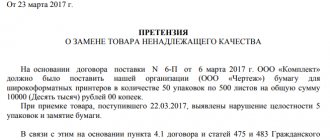published: 07/25/2018
Almost any company makes various transactions aimed at carrying out its core activities, or in order to provide some related needs. Such transactions may include not only the purchase of raw materials and supplies, but also the purchase of expensive equipment, including machine tools and units.
It should be noted right away that in this article we will not consider special categories of goods (for example, perishable goods, explosive, nuclear, space, chemical, etc.) or special subject composition (for example, consumers). Therefore, the text will focus on commonly used goods, the circulation of which is not limited on the territory of the Russian Federation and does not have special legal regulation.
It happens that the delivered product has defects. These can be external, internal (hidden), significant or insignificant shortcomings. Simply put, it happens that the buyer receives something completely different from what he expected when concluding the contract.
Of course, the buyer cannot influence these situations in any way, since they do not at all depend on his will. At the same time, any buyer can and probably should take some measures that will allow him to strengthen his position in the arbitration court in the future.
You may be interested in: Representation in arbitration court.
Inspection of goods upon acceptance
The choice of the sequence of actions and their content largely depend on the moment at which deficiencies are discovered. In any case, the most important step when identifying flaws is to fix them. If defects are discovered at the time of acceptance of the goods, the buyer is obliged to reflect this fact in the acceptance documents.
It is important to understand that if these shortcomings could be identified during an external visual inspection, then they are obvious. At the same time, judicial practice proceeds from the fact that if the transfer documents do not say anything about obvious defects, then it is considered that the buyer received the goods of proper quality.
This position is confirmed by numerous judicial practice (Definition of the Supreme Court of the Russian Federation dated October 14, 2016 N 307-ES16-12979 in case No. A05-12081/2015, Determination of the Supreme Court of the Russian Federation dated December 3, 2015 N 309-ES15-15020 in case N A60-15147 /2014, Resolution of the Arbitration Court of the Moscow District dated November 9, 2017 N F05-15391/2017 in case No. A41-4537/2017, Resolution of the Arbitration Court of the Volga District dated 05/29/2017 N F06-20218/2017 in case N A49-10008/2016 ). Thus, a priori, acceptance of goods without comments on their appearance is considered by the courts as evidence of the transfer of goods of proper quality.
From this we can draw one important conclusion - any product must be carefully inspected for integrity at the time of receipt. This does not mean that you need to immediately check the performance of the product on the spot or bring in experts. No. You just need to carry out an external visual inspection.
You may be interested in: Pre-trial dispute resolution.
If defects are found upon acceptance of the goods
If a defect is discovered upon acceptance, this must be recorded in the transfer document. Such a document can be: an act, a consignment note, a consignment note, a universal transfer document, unified forms of transfer documents, as well as generally any document that records the transfer of a document.
If the document does not contain a column intended to indicate the defects of the product, then you need to enter this information into it by hand, or draw up a separate document containing a description of the defects. The more detailed the shortcomings are described, the more it will be in the interests of the buyer.
The ideal option is to draw up an additional document, for example, a claim statement, in which the parties to the contract will describe the shortcomings identified during acceptance. Such an act can be drawn up immediately or within a reasonable period after acceptance, unless a different period is established by the contract, provided that the accompanying documents contain an indication of the presence of deficiencies.
When describing defects, special care should be taken, since an acceptance certificate that does not contain information about the quantity of low-quality products, a description of the defects identified and the method of acceptance of products for quality is not adequate evidence of the delivery of low-quality goods. A similar approach is found in judicial practice (Resolution of the Federal Antimonopoly Service of the Central District dated August 24, 2010 in case No. A35-589/08-C5, Determination of the Supreme Arbitration Court of the Russian Federation dated December 3, 2010 No. VAS-16308/10 in case No. A35-589/08-C5 ).
You may be interested in: Services for customs clearance of goods.
Refund due to non-compliance with stated specifications
“On the right side of the keyboard there are two hot keys: the speed switch key and the control change key. Four speed modes: “Normal”, “Accelerated”, “Turbo” and “Extreme” will allow you to get a tangible advantage in the game. The response time in Extreme mode is three times faster than that of a regular keyboard: only 7.92 milliseconds! Switching modes does not require installing additional drivers. “—these buttons are not there, and so are the functions.
We recommend reading: Increase in Tariff Prices From July 2020 Moscow Region Water
The waterproof properties of the keyboard are unique. Accidentally spilling liquid on the keyboard will not damage it. The A4Tech X7-G600 gaming model is designed to triple the weight of conventional keyboards to provide greater stability during intense gaming battles. “-holes taped with paper, what the hell with water resistance.
Division of responsibility for product defects
As a general rule, the seller is responsible for defects in the goods if the buyer proves that the defects in the goods arose before its transfer to the buyer or for reasons that arose before that moment (clause 1 of Article 476 of the Civil Code of the Russian Federation).
If a warranty period is established for the product, then a different rule applies - the seller is responsible for the defects of the product unless he proves that the defects of the product arose after its transfer to the buyer as a result of the buyer’s violation of the rules for using the product or storing it, or the actions of third parties, or force majeure ( paragraph 2 of article 476 of the Civil Code of the Russian Federation). In other words, with a warranty period, the burden of proof lies with the seller, that is, the presumption of innocence of the buyer applies; in the absence of a warranty period, the presumption of innocence of the seller. This presumption applies until the contrary is proven.
You may be interested in: Compensation for losses and recovery of damages in court.
The product does not meet the stated characteristics: how to get your money back
2. Before concluding a contract, the seller must provide the consumer with information about the basic consumer properties of the product, the address (location) of the seller, the place of manufacture of the product, the full brand name of the seller (manufacturer), the price and conditions for purchasing the product, about its delivery, service life, shelf life and warranty period, about the procedure for paying for the goods, as well as about the period during which the offer to conclude a contract is valid.
We recommend reading: Job Description for a Jewelry Seller
If the consumer refuses the goods, the seller must return to him the amount of money paid by the consumer under the contract, with the exception of the seller’s expenses for delivery of the returned goods from the consumer, no later than ten days from the date the consumer submits the corresponding demand.
Hidden defects during acceptance
Previously, we talked about those cases where a defect is discovered upon initial acceptance of the goods, and that a thorough external inspection must be carried out. However, most of the deficiencies are hidden and cannot be identified at the time of initial acceptance.
Within the meaning of Article 513 of the Civil Code of the Russian Federation, goods accepted by the buyer (recipient) must be inspected by him within the period determined by law, other legal acts, supply agreement or business customs.
The buyer (recipient) is obliged, within the same period, to check the quantity and quality of the accepted goods in the manner prescribed by law, other legal acts, agreements or business customs, and immediately notify the supplier in writing of any identified inconsistencies or defects in the goods.
Thus, as a rule, the period for discovery of defects is established by the contract. In the absence of an agreed period, such deficiencies must be discovered within a reasonable time. Accordingly, after initial acceptance, the product must be checked for functionality, tested, etc.
If defects are discovered beyond a reasonable period of time or in violation of the period established by the contract, the supplier may refuse to satisfy the buyer's claim related to the discovered defects.
By virtue of Articles 477, 483 of the Civil Code of the Russian Federation, the period for detecting defects is established by the contract. With regard to defects that may be identified by the buyer when using the goods, the parties can establish in the contract the period for their discovery (clause 1 of Article 477 of the Civil Code of the Russian Federation) and the period for notifying the supplier about the defects (clause 1 of Article 483 of the Civil Code of the Russian Federation).
This conclusion is also consistent with judicial practice (Resolution of the Arbitration Court of the Ural District dated November 10, 2017 No. F09-6865/17 in case No. A60-53804/2016, Resolution of the Federal Antimonopoly Service of the North-Western District dated August 16, 2006 in case No. A56-57715/ 2005, Resolution of the First Arbitration Court of Appeal dated February 16, 2016 in case No. A43-19980/2015).
You may be interested in: Contract development and review services.
Thus, in case No. F09-6865/17, the courts found that the contract provides for a special procedure - after discovering a discrepancy in quality, the buyer is obliged to immediately send a notification to the supplier and the shipper along with a copy of the initial acceptance certificate. Based on the results of joint acceptance, a joint acceptance act must be drawn up, and based on the results of acceptance carried out in the absence of a representative of the supplier and the shipper, a final acceptance act must be drawn up.
At the same time, the act was not drawn up and the notification was not sent immediately. In this connection, the courts came to a reasonable conclusion that the plaintiff significantly violated the procedure for accepting products. At the same time, the court indicated that the controversial defects of the goods were discovered outside the time limits established by Art. 477 of the Civil Code of the Russian Federation.
Violation of the procedure for accepting goods may be considered by the courts as a basis for declaring the fact of delivery of low-quality goods unproven.
Nuances and methods of returning equipment that you should know about
- Detected device defect;
- Poor performance of equipment;
- The device discharges quickly;
- There are no instructions in Russian;
- Incomplete set of goods;
- The seller misrepresented the possibilities of acquisition;
- The purchase does not meet the standards of proper quality.
Important rules under consumer protection law
- We detect a defect or manufacturing defect on the device.
- We submit an application for a refund.
- We return the product along with packaging, instructions and other details.
- We receive from the seller a completed report on sending the goods for examination.
- We expect up to 45 days.
- We receive a written response as the basis for filing a claim.
The law has determined that if the seller demands to return the product in its entirety, the item itself, its parts and components are returned. Packaging and parts of the product that wear out quickly and therefore could become unusable during initial use cannot be returned. It is better to include quickly wearing parts that have become unusable with the item being returned.
The purchased product does not always meet our expectations, and there is a need to return it. The reasons may be different: a detected defect, an incomplete set, an item that is not the right size, etc. It happens that the packaging is already damaged. Let's consider cases in which you can return goods without packaging.
Cases when the product must be returned with packaging
- The item must be intact, without signs of use,
- Maintaining the completeness of the product,
- No more than two weeks have passed since the date of purchase,
- Cash receipt saved
- The item must be returned in accordance with current legislation.
In court, the plaintiff must justify his position and, if necessary, request an independent examination. Remember that if you win a dispute in this category, you have the right to demand reimbursement from the defendant of all costs associated with going to court, including the full cost of the services of a professional lawyer.
We recommend reading: Objection to the Claim for Recovery of Representative Services
These requirements relate to the general procedure, and the return of equipment is an exception to this rule , since Government Decree No. 55 approved a list of goods that can be returned only if there is a confirmed manufacturing defect. Therefore, complex technical items, which include almost all electronics, are in practice very difficult to return without any good reason.
Useful video
- Make a written complaint.
- Indicate in the text of the application a link to the regulatory act that was violated by the actions of the store representatives.
- Send the document by registered mail with return receipt requested to the legal address of the organization.
- Expect a response within 10 days.
- If the seller refused or ignored your request, start preparing a statement of claim.
- Send a set of documents to the district court at the location of the company or individual entrepreneur.
In accordance with paragraph 4 of Art. 26.1 of the Law on the Protection of Consumer Rights, the buyer has the right to refuse the goods at any time before its transfer, and after the transfer of the goods, the return is carried out within 7 days from the date of delivery of the goods.
Defects of the goods after acceptance during the warranty period
If a warranty period or expiration date is not established for the goods, then claims related to defects in the goods may be presented by the buyer, provided that the defects in the sold goods were discovered within a reasonable time, but within two years from the date of transfer of the goods to the buyer or within more for a long period, when such a period is established by law or a purchase and sale agreement (clause 2 of Article 477 of the Civil Code of the Russian Federation).
The situation is different for goods that have a warranty period or expiration date. In this case, by virtue of paragraphs 3 and 4 of Article 477 of the Civil Code of the Russian Federation, the buyer has the right to make claims related to defects in the goods if defects are detected during the warranty period (expiration date).
If the seller has established a warranty period of less than two years, but the buyer still discovers defects within a two-year period, then the buyer has the right to expect the defects to be eliminated at the expense of the seller if he proves that the defects in the goods arose before the transfer of the goods to the buyer or for reasons that arose before this moment (clause 5 of article 477 of the Civil Code of the Russian Federation).
If defects are discovered after acceptance, the buyer is obliged to immediately notify the supplier about them, unless a different period is specified in the contract. Typically, such a communication is in the form of a claim or other written notice. If an excessively long period of time passes between the discovery of a defect and the presentation of the corresponding demand, then this circumstance may also serve as a basis for the supplier’s refusal to satisfy the stated requirement.
You may be interested in: Subscription legal services for foreign companies.
Product non-compliance with declared characteristics
I believe that in this case, you should first contact the “dealer” with a written complaint, because the phrase “go to court” is common among them. After an official written response, it will be possible to choose a position and initiate a lawsuit.
The situation is as follows, I purchased a car in the most complete configuration with additional equipment, in the contract and when purchasing the seller it was stated that the steering wheel, interior trim and inserts on the interior doors were genuine leather, subsequently after purchasing the car and after 1 month, I discovered that this is not leather, but ordinary leatherette, which, as everyone knows, is much cheaper and less wear-resistant than leather. The contract says that this is all LEATHER, I contacted the seller with a demand to reduce the cost and reimburse the difference, I was refused and asked to go to court. They said that this is what the Official Manufacturer states in the documents, but they are official dealers and the agreement was concluded with them by LLC.” “, and not with General Motors, which supposedly sends such documents, what should I do? Where to contact? What to expect? This is pure deception.
We recommend reading: Dates for issuing PPE 2020
How to record product defects
Often, the procedure for fixing defects is prescribed by the parties in the contract. However, in the absence of specific instructions, it is advisable to inspect the defects together with the supplier. For this purpose, the buyer should send a notice to the supplier of the need to conduct a joint inspection of the defects in the goods.
It is desirable that such an inspection be carried out with photo and video recording, with the results of the inspection recorded in a special act, protocol or other similar document. If the supplier does not appear for a joint inspection, then such an inspection is carried out unilaterally.
Expertise when supplying goods is not mandatory. However, often the obligation to conduct an examination is expressly provided for in the contract. In this case, it is advisable to be guided by the provisions of the contract and conduct an examination. To conduct an examination, it is also necessary to notify the counterparty of the need to appear for a joint examination. If the counterparty refuses to appear, the examination is carried out without his participation.
The results of an examination carried out without notifying the counterparty may be considered inadequate evidence. This conclusion is confirmed by judicial practice (Decision of the Supreme Court of the Russian Federation dated November 10, 2017 N 308-ES17-16420 in case N A32-36274/2016, Resolution of the Arbitration Court of the North-Western District dated August 11, 2014 N F07-5332/2014 in case N A56-52381/2013, Resolution of the Federal Antimonopoly Service of the Far Eastern District dated October 26, 2012 N F03-4695/2012 in case No. A04-6895/2011, Resolution of the Federal Antimonopoly Service of the Ural District dated May 16, 2011 N F09-2150/11-С3 in case No. A76- 14834/10-35-405).
If the contract provides for the obligation to transfer the goods to the supplier in order to establish the reasons for the occurrence of deficiencies, then it is advisable to record any deficiencies that have arisen before such transfer by carrying out photo and video recording and recording the inspection results in a special act, protocol or other similar document.
If the contract does not provide for the obligation to transfer the goods to the supplier for inspection and examination, then the decision on the need for transfer depends on the presence (absence) of a warranty period for the goods.
You may be interested in: Services of a dealer or distributor on the Russian market.
As has already been said, as a general rule, the seller is responsible for defects in the goods if the buyer proves that the defects in the goods arose before its transfer to the buyer or for reasons that arose before that moment (clause 1 of Article 476 of the Civil Code of the Russian Federation).
If a warranty period is established for the product, the seller is responsible for the defects of the product unless he proves that the defects of the product arose after its transfer to the buyer as a result of the buyer’s violation of the rules for using the product or storing it, or the actions of third parties, or force majeure.
From the above arguments, we can deduce the thesis that if a product has a warranty period, then if defects arise, the product should be transferred to the supplier, since the burden of proof lies with the supplier. If there is no warranty period, then it is not necessary to transfer the goods to the supplier and the initiative for proof must come from the buyer (the buyer himself can conduct an examination without transferring the goods to the supplier).
Topic: features of returning goods that do not meet the stated characteristics
The request to the support service of the equipment manufacturer was simply shocking - I called the technical support line, asked the question “does it work with IP TV?”, they answered me - it works! I’ll clarify where in the instructions this is said (the instructions are fresh, they have just been posted on the manufacturer’s website (since the manufacturer makes a disclaimer like: I reserve the right to make changes without additional notice)). They answer, “It doesn’t say anywhere, I just know!” )), but this is a bit of a digression from the topic,
On February 27, 2012, I made a purchase of a media player (which is confirmed by a receipt for payment for the goods and a cash receipt from the point of issue in Moscow). Before making a purchase, I familiarized myself with the “parameters” of the player, set out on the mstore website on the Internet information and telecommunications network. Moreover, the main criterion for my choice was that the site stated: “the player supports iptv.” Having contacted directly the “product delivery point” of the online store, I asked the seller whether this player could provide viewing of digital television - playlists of iptv channels (subject to the provision of the service by the Internet provider). the seller replied “yes, it can” and pointed me to the information contained on the website. After making a purchase, coming home and reading the instructions, I discovered that the media player does not support viewing digital television - playlists of iptv channels. I called the store and asked if it was possible to return it because... the product does not correspond to the declared characteristics, they said that it was possible, I came to them on March 5, but after 30 minutes of waiting, the head of the complaints department came out to me and, with an air of the universal significance of his position, said: you have been denied on the basis of a labor protection clause. I asked if they could confirm this to me in writing. They told me that they could, but when I asked him to specify on the basis of what specific provisions of the POZPP my refund was denied, he said that we would respond in writing.
Recording the stated requirement to eliminate defects in the delivered goods
Any requirement, of course, must be recorded. For example, this may be a two-sided complaint report drawn up in two copies (one remains with the buyer, the other with the supplier). Or it may be a claim, but it is important to record the fact that it was sent (delivered) to the supplier. Recording can be carried out by listing the attachments in a valuable letter. When sending a claim by mail, it is very important to keep the mailing receipt containing the tracking number.
If we talk about evidence of delivery of the claim (demand), then such evidence may be the supplier’s mark on the claim (demand). The mark, at a minimum, must contain the name (full name) of the supplier, information about the person who carried out the acceptance (position, full name), date and signature. Seals and stamps are affixed upon request, but will not be superfluous.
In addition to indicating the nature of the defects of the goods, the claim must contain a specific requirement in accordance with Article 475 of the Civil Code of the Russian Federation. Let us remind you that this can be: one of the following requirements:
- reduce the price of a product;
- eliminate the defect in the product free of charge;
- reimburse the buyer's expenses for eliminating the defects independently.
If the claim does not contain a specific requirement, for example, a requirement to eliminate defects free of charge, then it will not make sense due to its legal uncertainty.
It is probably not worth saying that the fact of presentation (sending) of any notifications at all, including the need to conduct a joint inspection or examination, must be properly recorded.
You may be interested in: Preparation of a legal opinion Legal Opinion.
Returning goods to the supplier that do not meet the stated characteristics
- A certain company purchased a large batch of goods to carry out its activities, but due to some circumstances was unable to use it. If the possibility of a return procedure was specified in advance in the contract, then, if necessary, this process will be launched.
- If the purchased product turns out to be defective or incomplete, the buyer also has the right to return the product to the supplier.
Let's look at some of the terms that are often used in business circles related to trade. A supplier is a seller who buys a group of goods or a single product for its subsequent sale. The supplier can be the manufacturer himself, who manufactured the product, or any private person or legal organization.
Additional measures to protect the rights of the buyer when delivering goods with defects
If the contract provides for payment after the transfer of the goods, then it is advisable for the buyer not to pay the remaining amount of the remuneration if defects are discovered.
The right to suspend counter-execution (in this case, this is the buyer’s obligation to pay for the goods) is expressly provided for by the provisions of Article 328 of the Civil Code of the Russian Federation. This norm is mandatory and cannot be canceled by agreement of the parties.
However, the decision to suspend payment must be accompanied by appropriate notice. This conclusion follows from the principle of good faith (clause 3 of article 1 of the Civil Code and clause 3 of article 307 of the Civil Code).
In particular, when establishing, fulfilling an obligation and after its termination, the parties are obliged to act in good faith, taking into account the rights and legitimate interests of each other, mutually providing the necessary assistance to achieve the goal of the obligation, as well as providing each other with the necessary information (clause 3 of Article 307 of the Civil Code of the Russian Federation ).
Currently, judicial practice has formulated the conclusion that the right to suspend a counter-obligation must be expressed in writing. Other behavior creates legal uncertainty when resolving the issue of proper performance or non-fulfillment of an obligation by a party (Resolution of the Arbitration Court of the North-Western District dated 05/23/2017 N F07-4902/2017 in case No. A56-16332/2016; Resolution of the Arbitration Court of the North-Western District dated 10/12/2016 N F07-6011/2016 in case N A56-36854/2015; Resolution of the Eighteenth Arbitration Court of Appeal dated 08/25/2017 N 18AP-9068/2017 in case N A07-5266/2017; Resolution of the Twentieth Arbitration Court of Appeal dated 02.02. 2017 N 20AP-6791/2016 in case N A62-1533/2016).
You may be interested in: Protecting consumer rights in court.
Non-compliance with the stated characteristics
First of all, you need to submit a claim through the online store website, in which you describe when and what product you bought, why you are unhappy and what you want (replacement of the product, refund). Please include with your claim a digital copy of your receipt confirming payment, a screenshot of the product description page, and a photo of the purchase made with a digital camera.
If the item does not have any defects, the process of returning it does not differ from the standard one, enshrined in Article 25 of the Law. Within the above deadlines, the buyer must provide the seller with a written claim and the goods themselves, which have retained their presentation and consumer qualities.
Letter of non-compliance of the product with the stated characteristics
How to correctly record the non-conformity of the goods that were delivered? If, during acceptance of the goods, the customer discovers that the quantity of goods supplied does not correspond to the quantity specified in the agreement of the parties, it becomes necessary to document this violation. It is for such cases that the following filling samples have been created:
- ...do not match in their completeness...
- ...does not meet the level provided...
- Upon receiving the goods...
- When unloading products...
- In the process of providing services...
- During testing...
- With the start of installation...
- During equipment setup it was discovered...
- Assembly of the product showed that...
- At the end of the trial operation, it was found that...
- As a result, it was established...
- ...product damage...
- ...discrepancy between the actual quantity of goods supplied and that indicated in the accompanying documents...
- ...inconsistency in the quality of the following types of services...
- ...violation of service procedures...
- The goods transferred to us turned out to be...
- ...of lower quality than...








